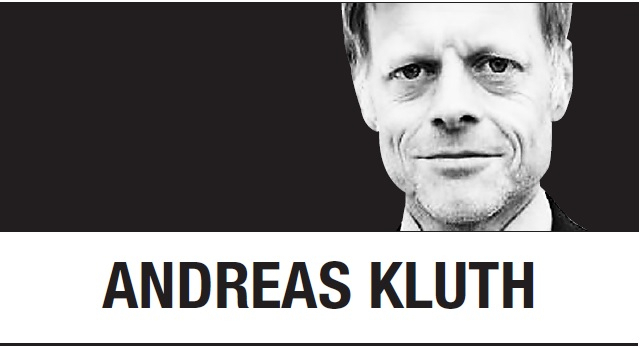
Since Feb. 24, 2022, and especially since Oct. 7, 2023, a specter has haunted the world and worried President Joe Biden in particular: Will Russia’s war against Ukraine, or Israel’s against Hamas, draw in other belligerents, perhaps even culminating in World War III?
Biden has therefore done everything in his power to support Ukraine and Israel while also keeping the US and its Western allies out of direct confrontations with Russia, Hamas’ backers in Iran, and their Chinese and North Korean quasi-allies. But conflicts change unpredictably. Every vagary increases the risk that an artillery round fired over here sends missiles flying over there and detonates a bigger blow-up.
Imagine, for example, a scenario that may seem far-fetched, but no more so than the odds in June 1914 that a deadly bullet fired in the Balkans by a Serbian nationalist at an Austrian prince should make Germany violate the neutrality of Belgium and cause the Great Powers of Europe to go to war.
Today’s version might run as follows. The mullahs in Tehran have just dispatched a warship to the Red Sea, where the Iran-backed Houthis have been attacking container ships, and a US-led flotilla policing the waters has sunk several Houthi boats in response. In future Houthi attacks and American counter-strikes, the Iranian destroyer must be seen to support its Houthi allies. So the Iranians could fire at the Americans, who’d shoot back and win the skirmish.
Tehran’s other proxies -- its so-called Axis of Resistance stretching from Lebanon to Syria, Iraq, and Yemen -- would then attack more Israeli or American targets. The Iranian mullahs will also order their own direct strikes, which the US and its allies will answer. At that point, the two nations are, de facto if not de jure, at war. Other powers in the region, from Turkey and Saudi Arabia to the Gulf states, will mobilize just to be ready.
Simultaneously, Russia, China and North Korea will rethink their own calculus. None of them has a formal mutual defense alliance with the others or with Iran. But they have formed connections and understandings that American pundits and politicians are now calling a new Axis of Evil.
That term “axis” is of course doubly loaded. It evokes the Axis of Germany, Italy and Japan during the last century and the “Axis of Evil” that former President George W. Bush invoked this century in the run-up to his invasion of Iraq. For Bush, the evil trio consisted of Iraq, Iran and North Korea.
Bush’s linkage of those three was iffy. Baghdad and Tehran had fought a bloody war and were united only by mutual loathing. Neither of them cared about Pyongyang’s interests, nor its dictator about theirs. But all in their own way saw Washington as the Great Satan and fantasized about slaying the beast.
Today’s autocratic quartet of Iran, Russia, China and North Korea has more in common than W’s trio did. China and Russia have declared a “no-limits” friendship, and even though Beijing is wary of the Kremlin, it wants to prevent Russia from losing in Ukraine and is buying its oil and other goods to circumvent Western sanctions. Iran is supplying Russia with drones to kill Ukrainians, and North Korea is sending ammo for the same purpose. Beijing and Moscow support Pyongyang.
Each member of this axis nonetheless has different aims. Russian President Vladimir Putin wants to subdue Ukraine and also eyes Moldova and other post-Soviet states, while claiming to defend Russia against the entire decadent West. His Chinese counterpart, Xi Jinping, wants to absorb Taiwan and also to bully American partners such as the Philippines out of the South China Sea.
Then there’s Pyongyang’s Kim Jong-un, who’s apparently decided to avail himself of the world’s preoccupation with Gaza to brandish his growing arsenal of nukes at South Korea, Japan and the US. In year-end speeches, he urged his army to get ready for war and “to sharpen the treasured sword” (that is, his atom bombs). Last year he launched a spy satellite and tested almost 30 ballistic missiles, many of which can reach the US; this year, he’ll probably try out many more.
Iran, Russia, China and North Korea aren’t an axis in the sense of coordinating their strategy. But they may yet behave like an axis if they think the US is distracted by the war in Gaza, paralyzed by domestic polarization, or exhausted from overstretch. If the US fights any one of them, the others may be tempted to open additional fronts.
Keeping them at bay will be hard, although Biden has the right strategy. It includes building variable alliances in Europe, the Middle East and Asia to stare down each adversary separately. It also entails trying to split Beijing from any emerging Axis of Evil by persuading Xi that China, as the world’s only other potential superpower, nowadays shares custody of world peace with the US. This, in fact, may be the world’s last best hope: An unlikely triumph of dual Sino-American leadership. We could call it an Axis of Stability.
Andreas Kluth
Andreas Kluth is a Bloomberg Opinion columnist covering US diplomacy, national security and geopolitics. -- Ed.
(Tribune Content Agency)
-
Articles by Korea Herald




















